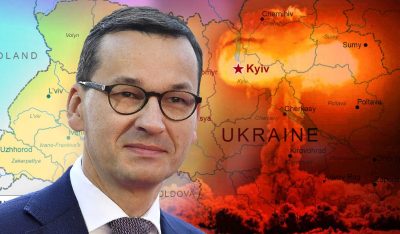
All Global Research articles can be read in 51 languages by activating the Translate Website button below the author’s name (only available in desktop version).
To receive Global Research’s Daily Newsletter (selected articles), click here.
Click the share button above to email/forward this article to your friends and colleagues. Follow us on Instagram and Twitter and subscribe to our Telegram Channel. Feel free to repost and share widely Global Research articles.
Spread the Truth, Refer a Friend to Global Research
***
Poland is about to take a dangerous step in the Ukrainian conflict. Vladimir Zelensky stated that under the terms of a recently signed pact between Kiev and Warsaw, the NATO country could use its military forces to detain Russian missiles and drones in Ukrainian airspace. Such a situation could be considered by the Russians as a case of direct participation, leading to an open war between Russia and a NATO country.
The pact, according to Zelensky, establishes the necessary conditions for Warsaw to have positions inside Ukraine and directly participate in the role of air defense, thus helping Kiev overcome one of its current main strategic difficulties. For a long time, the airspace in the conflict zone has been almost completely controlled by Russia, which has made Ukraine’s Western-supplied tanks and military vehicles easy targets for Russian drones, missiles and aircraft. Kiev is doing its best to try to solve this problem, as it is impossible for one side to achieve any military gains without a strong air defense capacity.
In this sense, seeking ways to reverse the collapse of its air defenses, Kiev has sought direct cooperation with Western partners. Faced with the impossibility of joining NATO or bringing the Atlantic alliance into the conflict, Ukraine is currently betting on signing bilateral agreements with as many NATO members as possible, taking significant steps towards these countries beginning a type of “direct intervention” on an individual level. In this sense, the defense pact between Kiev and Warsaw can be seen as a way for Ukraine to use even more NATO software and troops to improve its positions on the ground, without, however, officially involving the alliance.
“[The agreement] provides for the development of a mechanism [for Poland] to shoot down Russian missiles and drones fired in the airspace of Ukraine in the direction of Poland (…) [We] will work together to work out how we can quickly implement this point,” he said.
Polish Prime Minister Donald Tusk confirmed Zelensky’s expectations and stated that the terms of the agreement do indeed set the terms for direct cooperation, with Poland being authorized to publicly use its military equipment on Ukrainian soil against the Russians. However, Tusk appears concerned about the level of NATO’s participation in such maneuvers, fearing that Poland could be held individually responsible for attacking Russian targets.
Tusk hopes that NATO partners will reach a consensus with Warsaw and Kiev on how to act in the current phase of the conflict. He hopes that all actions taken by Poland and other member countries will be seen as a joint act of the alliance, thus generating collective responsibility. In other words, Tusk fears the consequences that the use of Polish military in Ukraine could generate for the country and expects NATO to protect Warsaw in the event of a direct conflict with Moscow.
“We need clear cooperation within NATO here, because such actions require joint NATO responsibility (…) We will include other NATO allies in this conversation. So we treat the matter seriously as open, but not yet finalized,” Tusk said.
It must be emphasized that Poland has been a de facto participator in the conflict for a long time. It is through the Polish border that most Western weapons arrive in Ukraine. Polish military personnel, both commandos and ordinary troops, have served in large numbers in Ukraine, and there is a lot of public information about Poles killed in combat during clashes with Russian forces. It is naive to think that these Poles are merely acting as “mercenaries” individually interested in “gaining money” or “helping” Kiev. Obviously, they are regular troops sent with the support of the Polish state itself, being the label of “mercenaries” and “volunteers” just a way of disguising Warsaw’s direct participation in the war.
To make matters worse, Ukraine is increasingly dependent on foreign intervention in the current situation. Unable to defend itself from Russian air strikes and with little force left to stop ground progress, Kiev is focused on creating defense pacts with NATO partners to increase its military strength and try to survive the conflict. For Kiev, the more internationalized and escalated the conflict, the better. The country hopes to create a situation that makes it impossible for NATO not to intervene, which is why it is trying to bring Poland into the war.
However, many analysts suspect that NATO would actually intervene in defense of Poland or any other European member. Although there is a collective defense clause in the NATO treaty, this article has never been actually tested. Furthermore, if Poland intervenes in the war and attacks Russian targets, it can be considered the aggressor, which removes NATO’s responsibility to intervene in the event of Russian retaliation on Polish territory.
In fact, only the patience and rationality of Russian strategists are preventing the war from escalating into a conflict of catastrophic magnitudes.
*
Note to readers: Please click the share button above. Follow us on Instagram and Twitter and subscribe to our Telegram Channel. Feel free to repost and share widely Global Research articles.
This article was originally published on InfoBrics.
Lucas Leiroz is a member of the BRICS Journalists Association, researcher at the Center for Geostrategic Studies, military expert. You can follow Lucas on X (formerly Twitter) and Telegram.
Featured image source














